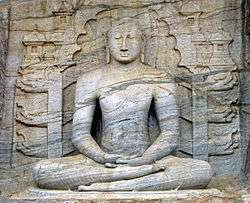Subcommentaries, Theravada
| Part of a series on |
| Theravāda Buddhism |
|---|
 |
The subcommentaries (Pali: tika, ṭīkā) are primarily commentaries on the commentaries (Pali: atthakatha) on the Pali Canon of Theravada Buddhism, written in Sri Lanka.[1] This literature continues the commentaries' development of the traditional interpretation of the scriptures. (Note that some commentaries are apparently also named with the term tika.) These subcommentaries were begun during the during the reign of Parakramabahu I (1123–1186) under prominent Sri Lankan scholars such as Sariputta Thera, Mahakassapa Thera of Dimbulagala Vihara and Moggallana Thera.[2]
Burmese collection
The official Burmese collected edition contains the following texts:[3]
- Paramatthamanjusa, tika by Dhammapala on Buddhaghosa's Visuddhimagga; scholars have not yet settled which Dhammapala this is
- Three tikas on the Samantapasadika, commentary on the Vinaya Pitaka:
- Two tikas on the Kankhavitarani, commentary on the Patimokkha
- Tikas by Dhammapala on Buddhaghosa's Sumangalavilasini, Papancasudani and Saratthapakasini, commentaries on the Digha, Majjhima and Samyutta Nikayas; it is generally considered by scholars that this is a different Dhammapala from the one who wrote commentaries.
- Visuddha(jana)vilasini by Nanabhivamsa, head of the Burmese sangha, about 1800; a new partial tika on the Sumangalavilasini, covering only the first volume of the Digha Nikaya
- Saratthamanjusa by Sariputta on Buddhaghosa's Manorathapurani on the Anguttara Nikaya
- Nettitika'' on Dhammapala's commentary on the Netti
- Nettivibhavini'' by a 16th-century Burmese author whose name is given in different manuscripts as Saddhamma-, Samanta- or Sambandha-pala; this is not a new tika on the Netti commentary, but a new commentary on the Netti itself
- Mulatika by Ananda on the commentaries on the Abhidhamma Pitaka
- Anutika on the Mulatika
There are other tikas without this official recognition, some printed, some surviving in manuscript, some apparently lost. The name tika is also applied to commentaries on all non-canonical works, such as the Mahavamsa. There are also some subcommentaries in vernacular languages.
Extracts from some of these works have been translated, usually along with translations of commentaries.
References
- ↑ Griffiths, Paul J. (1994). On Being Buddha: The Classical Doctrine of Buddhahood. SUNY Press. pp. 33–34. ISBN 9780791421277.
- ↑ Perera, HR; Buddhism in Sri Lanka A Short History, Buddhist Publication Society, Kandy, Sri Lanka, page
- ↑ "Buddhist literatures in archives".